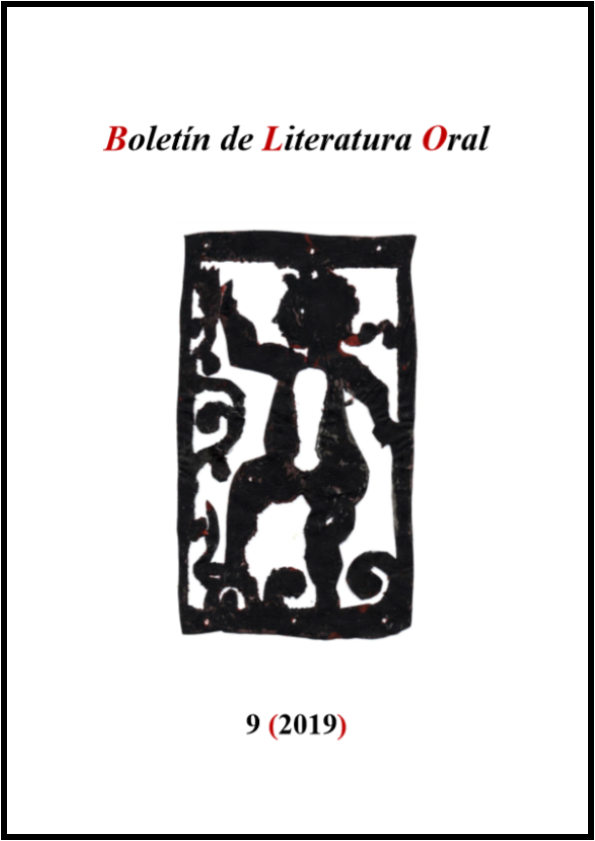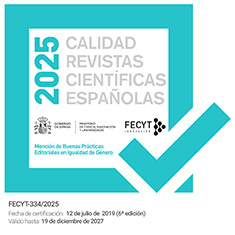La anciana y el robo del fuego. Tipología y distribución de las variantes del mito
Palabras clave:
fuego, robo, mito, anciana, bastónResumen
En este artículo presentamos una familia de relatos acerca de la obtención del fuego por mediación o con el auxilio de una anciana. Se revisan varias versiones que han sido documentadas en el Mediterráneo, en Oceanía y en América, y se describen, además, las ramas y variantes más significativas del mito.
Descargas
Referencias
BARTOLOMÉ, Miguel Alberto y BARABAS, Alicia (1982): Tierra de la palabra. Historia y etnografía de los chatinos de Oaxaca, Oaxaca, Instituto Nacional de Antropología e Historia / Centro Regional de Oaxaca.
BERENGER-FERAUD, Laurent Jean Baptiste (1891): «Le feu de Prométhée chez les provençaux de nos jours», La tradition. Revue générale des contes, légendes, chants, usages, traditions et arts populaires, 5, 129-132.
BROMILOW, William Edward (1912): «Dobuan (Papuan) Beliefs and Folklore», Report of the Thirteenth Meeting of the Australasian Association for the Advancement of Science held at Sidney, 1911, pp. 425-426.
BROUGH SMYTH, Robert (1878): The aborigines of Victoria. With notes relating to the habits of the natives of other parts of Australia and Tasmania, 2 vols., Londres, Trubner, vol. I.
CURTIN, Jeremiah (1898): Creation Myths of Primitive America, Boston, Little Brown.
DE HOLLENBACH, Elena Erickson (1977): «El origen del sol y de la luna. Cuatro versiones en el trique de Copala», Tlalocan, 7, 123-170.
FRAILE VELÁSQUEZ, Jenny Nohemí (2013): «Miradas al análisis de cuatro mitos venezolanos desde la perspectiva de Lévi-Strauss de lo crudo y lo cocido», Revista de Comunicación de la Sociedad Española de Estudios de la Comunicación Iberoamericana, 17/31, pp. 88-114.
FRAZER, James George (1930): Myths of the Origin of Fire, Londres, Macmillan.
GABRID SELIGMANN, Charles (1910): The Melanesians of British New Guinea, Cambridge, Universidad de Cambridge.
GIDDINGS, Ruth Warner (2008, 1959 para la primera edición): Yaqui myths and legends, Tucson, Universidad de Arizona.
GREY, George (1855): Polynesian Mythology & Ancient Traditional History of the New Zealand Race, Londres, John Murray.
GRIMBLE, Rosemary (2004, 1972 para la primera edición): Migrations, Myth and Magic from the Gilbert Islands. Early Writings of Sir Arthur Grimble, Londres, Routledge.
HADDON, Alfred Cort (1908): Reports of the Cambridge Anthropological Expedition to Torres Straits, 6 vols. (1901-1935), Cambridge, Cambridge University Press, vol. VI.
HAMILTON, Robert (1885): «Australian traditions», The Scottish Geographical Magazine, 1/7, pp. 283-286.
HOME THOMSON, Basil (1902): Savage Island. An Account of a Sojourn in Niué and Tonga, Londres, John Murray.
HOPKINS, Patrick (1998): Sex / Machine. Readings in Culture, Gender, and Technology, Bloomington e Indianápolis, Universidad de Indiana.
HOWITT, Alfred William (1904): The Native Tribes of South-East Australia, Londres, Macmillan.
HUNT, Archibald (1899): «Ethnographical Notes on the Murray Islands, Torres Straits», Journal of the Anthropological Institute, 28/1, p. 19.
ICHON, Alain (1973): La religión de los totonacas de la sierra, México D.F., Instituto Nacional Indigenista / Secretaría de Educación Pública.
INCHÁUSTEGUI DÍAZ, Carlos (1977): Relatos del mundo mágico mazateco, México D.F., Centro Regional Puebla-Tlaxcala / Instituto Nacional de Antropología e Historia.
KARSTEN, Rafael (1919): Mitos de los indios jíbaros (shuará) del oriente del Ecuador, Quito, Boletín de la Sociedad Ecuatoriana de Estudios Históricos Americanos.
KOCH-GRÜNBERG, Theodor (1920): Indianermärchen aus Südamerika, Lena, Eugen Diederichs.
LEVI-STRAUSS, Claude (1964): Le cru et le cuit, París, Plon.
LÓPEZ AUSTIN, Alfredo (2006, primera edición de 1990): Los mitos del tlacuache. Caminos de la mitología mesoamericana, México D.F., UNAM.
LUOMALA, Katherine (1949): Maui-of-a-thousand-tricks. His Oceanic and European biographers, Honolulu, Bishop Museum.
PEDROSA, José Manuel (2003): «Lo crudo y lo cocido: teoría, símbolo, texto (de Lévi-Strauss al cuento tradicional», Revista de Folklore, 23/266, pp. 39-54.
PEDROSA, José Manuel (2001): «Literatura, antropología y psicoanálisis: Prometeo, Freud y Lévi-Strauss», Literary Research, 18/35, pp. 70-78.
PEDROSA, José Manuel (2000): «Del Himno a Démeter pseudo-homérico al romance de La nodriza del infante. Mito, balada y literatura», Rafael Beltrán (ed.), Historia, reescritura y pervivencia del romancero. Estudios en memoria de Amelia García-Valdecasas, Valencia, Universidad de Valencia, pp. 157-185.
PEDROSA, José Manuel, ASTIGARRAGA, Asier y KALZAKORTA, Jabier (2008): Gilgamesh, Prometeo, Ulises y San Martín. Mitología vasca y mitología comparada, Vitoria, Fundación José Miguel de Barandiaran.
PREUSS, Konrad Theodor (1912): Die Nayarit-Expedition. Textaufnahmen und Beobachtungen unter Mexikanischen Indianern, 3 vols., Leipzig, B. C. Teubner, vol. I.
PREUSS, Konrad Theodor (1994, 1921-1923 para la edición original en alemán): Religión y mitología de los uitotos. Recopilación de textos y observaciones efectuadas en una tribu indígena de Colombia, Suramérica, 4 vols., Ricardo Castañeda Nieto (trad.): Bogotá, Universidad Nacional, vol. I.
RABARIJAONA, Harinirinjahana (2007): «Mitos y leyendas de Madagascar», Oráfrica, 3, pp. 139-180.
RAMÍREZ CELESTINO, Cleofás y FLORES FARFÁN, José Antonio (1995): El tlacuache (Tlakwatsin), México D.F., Comisión Nacional de los Derechos Humanos / CIESAS / Linguapax.
RIDLEY, William (1873): «Report on Australian Languages and Traditions», Journal of the Anthropological Institute, 2.
ROJAS, Emilio (2008): Leyendas, cuentos, fábulas, apólogos y parábolas, México D.F., Expresión y tiempo.
ROTH, Walter Edmund (1915): «An inquiry into the Animism and Folk-lore of the Guiana Indians», Thirtieth Annual Report of the Bureau of American Ethnology 1908-1909, Washington, Government Printing Office, pp. 103-386.
TAGGART, James (1983): Nahuat myth and social structure, Austin, Universidad de Texas.
TAYLOR, Richard (1870): The Ika A Maui or New Zealand and its Inhabitants, Londres, Wertheim and Macintosh.
THOMPSON, Stith (1955-1958): Motif-Index of Folk Literature. A Classification of Narrative Elements in Folktales, Ballads, Myths, Fables, Mediaeval Romances, Exempla, Fabliaux, Jest-Books and Local Legends, Bloomington, Universidad de Indiana-Rosenkilde & Bagger.
TOMLINSON, Samuel: «The Fire and the Dog», The Papuan Villager, 15 de febrero de 1929.
TURNER, George (1884): Samoa a hundred years ago, and long before, together with notes on the cults and customs of twenty three other islands in the Pacific, Londres, Macmillan.
URQUHART, Frederic Charles (1885): «Legends of the Australian Aborigines», Journal of the Anthropological Institute, 14/1, pp. 87-88.
WATERMAN, Patricia Panyity (1987): A Tale-Type Index of Australian Aboriginal Oral Narratives, Helsinki: Suomalainen Tiedeakatemia-Academia Scientiarum Fennica, FF Communications, núm. 4590.
WHITE, John (1889): The Ancient History of the Maori. His Mythology and Traditions, 6 vols. (1887-1890), Londres, George Didsbury, vol. II.
WILLIAMS GARCÍA, Roberto (1972): Mitos tepehuas, México D.F., Secretaría de Educación Pública.
WILLIAMS GARCÍA, Roberto y GARCÍA RAMOS, Crescencio (1980): Tradición oral en Tajín, Xalapa, Cultura de Veracruz.
WYATT GILL, William (1876): Myths and Songs from the South Pacific, Londres, Henry S. King.
Descargas
Publicado
Número
Sección
Licencia
Los autores que publican en esta revista están de acuerdo con los siguientes términos:
- Los autores conservan los derechos de autor y garantizan a la revista el derecho de ser la primera publicación del trabajo al igual que licenciado bajo una Creative Commons Attribution License que permite a otros compartir el trabajo con un reconocimiento de la autoría del trabajo y la publicación inicial en esta revista.
- Los autores pueden establecer por separado acuerdos adicionales para la distribución no exclusiva de la versión de la obra publicada en la revista (por ejemplo, situarlo en un repositorio institucional o publicarlo en un libro), con un reconocimiento de su publicación inicial en esta revista.
- Se permite y se anima a los autores a difundir sus trabajos electrónicamente (por ejemplo, en repositorios institucionales o en su propio sitio web) antes y durante el proceso de envío, ya que puede dar lugar a intercambios productivos, así como a una citación más temprana y mayor de los trabajos publicados (Véase The Effect of Open Access) (en inglés).
























